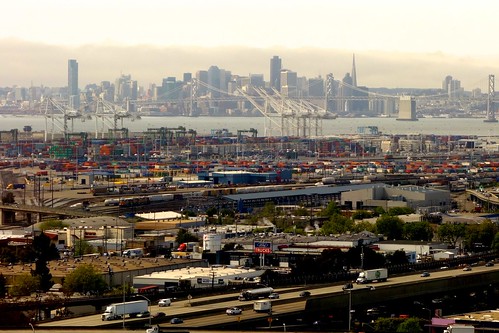
flickr photo shared by 1Flatworld under a Creative Commons ( BY-NC-ND ) license
Yesterday California Governor Jerry Brown help a press conference at the Port of Oakland to call for a bipartisan solution to fund the state's needed highway reapairs. Brown was evasive about the actual mechanisms to be used to raise funds, refusing to say anything about taxes.
Then how can the state fund these necessary improvements? A recent report from ITS Davis,"A Funding Compromise Can Set Transportation on Path Toward Sustainability", proposes:
The funding recommendations include a one-time use of corporate taxes to allow states to reduce the backlog of maintenance needs. The federal gas tax would be continued and indexed to inflation. Greenhouse gas (GHG) reduction targets would be set for each state and states would be allowed to ‘buy down’ their gas tax as they reduce their GHG emissions. States would be given pricing and tolling authority and have the authority to implement a vehicle miles traveled (VMT) tax. States would also assume responsibility for all roads. Taken together, these strategies would set transportation on the path toward sustainability.
For VMT-based pricing, we're still waiting for conclusive numbers from Oregon's recent implementation. Research has indicated that other types of road-pricing in California will need to be tailored to specific regions to be successful. It clear that even without the political will to raise it, the gas tax alone is not stable enough to fund the infrastructure repairs on the horizon.
Sources:
- Madowitz, M., and K. Novan. 2013. “Gasoline Taxes and Revenue Volatility: An Application to California.” Energy
Policy 59 (August): 663–73. doi:10.1016/j.enpol.2013.04.018. - Niemeier, Deb. 2015. “A Funding Compromise Can Set Transportation on Path Toward Sustainability.” University of
California, Davis. https://merritt.cdlib.org/d/ark:%252F13030%252Fm5fx9jd4/1/producer%252FNCST-
20150714.pdf. - Smirti, Megan, Alexandra Evans, Michael Gougherty, and Eric Morris. 2007. “Politics, Public Opinion, and Project
Design in California Road Pricing.” Transportation Research Record: Journal of the Transportation Research Board
1996 (January): 41–48. doi:10.3141/1996-06. - Swan, Rachel, and John Wildermuth. 2016. “Governor Wants Bipartisan Fix for State Highway Repairs.” SFGate.
Accessed January 26. http://www.sfgate.com/politics/article/Governor-wants-bipartisan-fix-for-state-highway-
6453851.php. - “VIDEO: Four Ways Jerry Brown Dodges Tax Question.” 2016. Sacbee. Accessed January 26.
http://www.sacbee.com/news/politics-government/capitol-alert/article31560077.html.